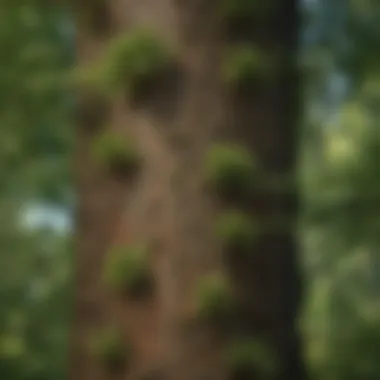Mastering Tree Trimming: Know How Much to Cut


Intro
Tree trimming is a common practice that often goes unnoticed until the consequences become visually evident. Balancing the need for aesthetic landscape and the health of trees requires a nuanced understanding of how much to trim. The volume of tree removal is not merely a matter of preference but is deeply intertwined with tree species, growth patterns, and long-term health considerations. In this section, we will explore the complexities of determining the appropriate amount to cut from a tree, delving into factors that influence this decision. This understanding serves as the foundation for effective tree care.
Understanding Woodland Ecosystems
The consideration of tree trimming is not isolated. It exists within the broader context of woodland ecosystems. The health of individual trees contributes to the overall biodiversity and stability of a forest.
Importance of Biodiversity in Forests
Biodiversity encompasses the variety of life within a given ecosystem. Healthy forests, rich in biodiversity, offer numerous benefits including habitat provision, soil stabilization, and opportunities for nutrient cycling. When trimming trees, one should remember that excessive removal can disrupt these intricate networks, affecting both flora and fauna.
Role of Forests in Climate Regulation
Forests play a crucial role in regulating environmental conditions. They act as carbon sinks, absorbing carbon dioxide and releasing oxygen. Effective tree management, including appropriate trimming techniques, contributes to this balanced cycle. Missing the mark in trimming can lead to reduced tree vigor, impacting their ability to cope with climate variability and diminishing their role in climate health.
Sustainable Forestry Practices
Stewardship of forest resources encompasses sustainable forestry practices. These practices help maintain forest health while allowing for individual tree care.
Principles of Sustainable Forestry
Sustainable forestry relies on several principles:
- Conservation of biodiversity: Preserving diverse species ensures ecosystem resilience.
- Minimizing environmental impact: Trimming should leave the ecosystem intact, fostering growth and health.
- Long-term planning: Consideration for future tree spacing and growth patterns guides trimming decisions.
Case Studies of Successful Implementations
There are several documented cases where sustainable practices improved tree health and forest stability. For example, in temperate regions, selective thinning has been employed effectively, allowing sunlight penetration without harming remaining trees. These examples demonstrate the practical application of theory in real-world scenarios.
Woodland Stewardship Techniques
Managing woodlands requires a thoughtful approach that considers both immediate and long-term impacts.
Forest Management Plans
A forest management plan is a strategic guide that outlines objectives related to tree maintenance, including trimming practices. These plans emphasize:
- Assessment of tree health: Regular evaluations ensure timely interventions.
- Trimming schedules: Determining optimal times for cutting back ensures minimal disruption.
- Monitoring outcomes: Observing the results of trimming decisions informs future practices.
Conservation Strategies
To preserve ecosystem balance, conservation strategies must be ongoing. These can include creating buffer zones around significant trees, implementing controlled trimming guidelines, and fostering community involvement in tree care. Overall, the goal is to harmonize human interests with nature's needs.
"Understanding how to trim trees responsibly is not just an act of maintenance; it is a commitment to the ecosystem's integrity."
Understanding Tree Trimming
Understanding tree trimming is crucial for anyone looking to maintain the health and vitality of their trees. This essential practice goes beyond just aesthetics; it affects the tree's growth, safety, and overall well-being. A properly trimmed tree can promote better air circulation and sunlight penetration, allowing for healthy leaf development. Conversely, improper trimming can lead to detrimental effects on the tree, potentially stunting its growth or rendering it vulnerable to diseases.
Tree trimming is necessary for several reasons. It helps in the removal of dead or diseased branches, which, if left unattended, can compromise the health of the entire tree. Additionally, trimming can shape a tree's canopy, preventing it from growing too close to structures or power lines, which is critical for safety. The art of trimming also engages with the ecological balance, as maintaining trees can foster habitats for local wildlife. These are just a few considerations that emphasize the importance of tree trimming.
Definition of Tree Trimming
Tree trimming refers to the selective removal of certain parts of a tree, particularly branches and stems. This practice is different from tree felling, where the entire tree is cut down. Trimming may involve cutting back overgrown branches to promote a healthier tree structure or facilitate the tree's growth in a specific direction. Depending on the type of tree and the goals of the trimming, it can involve various techniques and tools. In the broader sense, it includes any actions taken to control the size, shape, or health of a tree.


Importance of Tree Trimming
The significance of tree trimming cannot be overstated.
- Health Benefits: Regular trimming helps to maintain tree health by removing diseased or dead branches. This practice minimizes the risk of decay that can spread through the tree.
- Safety: Trimming is essential for safety reasons. Overhanging branches can become hazardous during storms or high winds, potentially causing damage to property or people.
- Aesthetic Appeal: Properly trimmed trees enhance the visual appeal of landscapes. It allows for better design and structuring of outdoor spaces.
- Growth Control: Trimming encourages new growth and allows trees to maintain an appropriate size. This helps manage the amount of space a tree occupies, particularly in urban settings.
- Increased Sunlight and Airflow: Thinning the canopy of a tree lets more sunlight in and encourages airflow, reducing the chances of fungal infections.
In summary, understanding the depth of tree trimming is essential for both aesthetics and ecological health. It requires informed decisions based on various factors to yield the best outcomes.
Factors Influencing Trimming Decisions
Tree Species
The species of a tree plays a crucial role in trimming decisions. Different species have varied growth habits and tolerances to pruning. For example, certain trees like maples and oaks have distinct characteristics that require careful attention. According to research, many conifers do not respond well to heavy trimming, while other broadleaf species may tolerate it better.
Key Considerations:
- Understand specific growth patterns of the species.
- Identify the species’ typical response to trimming.
- Differentiate between ornamental and shade trees, as each may require different approaches.
Tree Age and Growth Stage
The age and growth stage of a tree are significant factors to consider when planning to trim. Young trees have different needs compared to mature ones. Young trees often benefit from formative pruning, which assists in developing a strong structure. As trees mature, their needs change. Excessive trimming may harm older trees, leading to stress and decline.
Essential Points:
- Young trees should generally be pruned lightly.
- Regular checks are vital for mature trees to avoid over-trimming.
- Timing is critical; prune at the right intervals to promote healthy growth.
Current Tree Health
Assessing the current health of a tree is imperative before making any trimming decisions. A healthy tree can withstand more aggressive trimming than one that is stressed or diseased. Factors such as pest infestations, diseases, or environmental stressors greatly influence how much a tree should be trimmed back. Consult with an arborist if unsure about the tree's health condition.
"Assessing the tree's health is the first step in making informed trimming decisions."
Health Assessment Checklist:
- Inspect for signs of disease like leaf discoloration.
- Check for structural issues such as dead branches.
- Evaluate the overall growth rates compared to other trees of the same species in similar environments.
Understanding these factors is essential to create a balanced approach to tree trimming. Each decision will significantly affect the tree's longevity and health. By focusing on tree species, age, and health, tree care practices can become effective and sustainable.
General Guidelines for Trimming Trees
Understanding the general guidelines for trimming trees is crucial for anyone involved in tree care, whether they are casual gardeners or forestry professionals. Effective tree trimming not only promotes tree health but also ensures safety for surrounding structures and environments. Proper trimming can reduce chances of disease, improve air circulation and light penetration, and contribute to the aesthetic value of the landscape. In this section, we delve deeper into specific components that govern the trimming process.
Timing Considerations
Timing is a key factor in tree trimming. Certain trees may respond differently to trimming depending on the season.
- Dormant Season: Most trees benefit from pruning during their dormant period, typically late winter to early spring. This timing minimizes stress on the tree and allows for vigorous growth when the season changes.
- Growing Season: Pruning during the growing season can lead to excessive sap loss for some species. However, light trimming can also encourage new growth and improve overall tree structure.
- Flowering Trees: Species that bloom in spring often require special attention. Pruning should be done immediately after flowering to avoid cutting off next year's blooms.
Choosing the right time enhances the effectiveness of trimming actions and reinforces tree vigor. This decision also requires an understanding of local climate variations which can affect the tree’s growth cycle.
Pruning Techniques
Mastering proper pruning techniques ensures tree trimming is effective while maintaining the tree's health. Understanding various methods is essential for different tree species. Here are some basic techniques:
- Thinning: This involves selectively removing branches to improve air circulation and sunlight penetration. This technique reduces the risk of diseases by allowing better airflow.
- Heading Back: This method entails cutting a branch back to a bud to promote new growth. It can help maintain size control but may lead to dense regrowth if done excessively.
- Crown Reduction: Aimed at lowering the height of a tree, this technique requires careful planning to avoid weakening the tree structure. Proper execution is vital to maintain tree balance and health.


"Using improper pruning techniques can lead to significant tree stress and may shorten its lifespan. Always approach trimming with knowledge of the species and specific needs of the tree."
Learning and applying correct pruning techniques creates a balance between aesthetics and tree health. Awareness of these guidelines can significantly extend the life and vitality of trees, making them resilient in their environment.
How Much to Trim: Specific Recommendations
Tree trimming is a nuanced task, crucial for maintaining the vitality of trees. Each species has its own rhythm of growth and response to trimming. Understanding specific recommendations can greatly influence the outcome of tree health and structure. By following guided recommendations, you foster better growth, reduce disease risks, and ensure an aesthetically pleasing form.
General Rule of Thumb for Healthy Trees
For healthy trees, a standard guideline suggests removing no more than 25% of the tree’s foliage in a single season. This percentage serves as a conservative measure to prevent shock. When trimming, focus on removing any dead or diseased branches. Also, consider enhancing airflow and sunlight penetration. Effective trimming promotes growth while maintaining the tree's structural integrity.
One way to remember this is: "Less is more, especially with healthy trees." By adhering to the 25% rule, you minimize the risk of stressing the tree, thus preserving its overall health.
Trimming too aggressively can lead to significant long-term damage, stunting growth and increasing vulnerability to pests.
Guidelines for Young Trees
Young trees require special attention as they establish their root systems. When pruning young trees, aim to shape them rather than drastically reduce their size. Remove 10% to 20% of the canopy if needed. Focus on guiding their structure by trimming any competing branches. This assists in developing a strong central leader, which is crucial for the stability of the tree as it matures.
Encouraging young trees to grow properly ensures they adapt well to their environment, ultimately resulting in robust growth patterns. Regular small trims are more effective than waiting for extensive work later.
Guidelines for Mature Trees
Mature trees possess a more established form, and trimming should be approached with respect. For these trees, consider a 15% to 20% reduction in crown density. This ensures the tree retains a balanced structure while allowing for necessary removal of any weak or crowded branches. It is also essential to evaluate if deadwood removal is necessary to improve health and aesthetics.
Additionally, when a mature tree shows signs of decline, such as excessive crown density or pest infestation, adjust your trimming approach accordingly. It might mean trimming branches slightly heavier than the average guidelines. Always assess the tree’s condition before deciding on the extent of trimming needed.
These tailored guidelines help ensure that the specific trimming needs of healthy, young, and mature trees are met, ultimately leading to successful tree maintenance.
Assessing the Consequences of Over-Trimming
Understanding the impact of over-trimming is essential for anyone involved in tree maintenance. The consequences go beyond aesthetic appearances; they affect the overall health and longevity of the tree. Over-trimming can lead to immediate physical effects and long-term health issues that may compromise the very vitality of a tree.
Immediate Effects
One of the most noticeable immediate effects of over-trimming is the stress placed on trees. Cutting them back too aggressively can lead to a sudden loss of foliage. Each leaf plays a crucial role in photosynthesis, helping the tree convert sunlight into energy. Without adequate leaf coverage, a tree may struggle to gather sufficient energy for growth.
Additionally, over-trimming can expose inner tissues to harsh environmental factors. Trees naturally rely on their bark and foliage as protection against insects and diseases. When trimmed excessively, the fresh cuts become vulnerable to infestations and pathogens. This can manifest in several ways:
- Leaf scorch: A sudden loss of foliage can cause the remaining leaves to experience scorch if they cannot handle the sudden change in sunlight exposure.
- Water stress: The shock of missing branches can interfere with a tree's ability to manage water needs, leading to wilting or dying branches.
- Increased susceptibility to pests: Open wounds attract pests, making the tree more vulnerable to infestations.
Long-Term Health Implications
The long-term health of a tree may be at serious risk if over-trimming occurs frequently or excessively. Cut branches may not regenerate, which can have several cascading effects:
- Reduced growth potential: Trees depend on leaves for photosynthesis. With fewer leaves, growth may slow significantly, which can lead to stunted development.
- Disrupted overall structure: A well-trimmed tree maintains a specific architecture. Over-trimming can create imbalances that lead to uneven growth or branching, which may make the tree unstable.
- Cascading effects on ecosystems: Trees contribute to local ecosystems. An unhealthy tree can disrupt habitats for birds and insects, affecting biodiversity. For instance, a single tree can be a home for various species; harming it impacts more than just the tree itself.
In summary, assessing the consequences of over-trimming is vital in tree care. Immediate effects may be alarming, but the long-term implications can be detrimental. Proper trimming practices minimize these risks, protecting trees for future generations. Maintaining balance is the key to sustaining healthy trees.
Tools and Techniques for Effective Trimming
Effective tree trimming requires the appropriate tools and techniques. Proper equipment ensures not only effective cutting but also the overall health of the tree. Using the right tools can minimize damage to the tree and make the process easier for the person trimming. Each tool has a unique function that can enhance the efficiency of the trimming process. Understanding these tools is crucial for anyone involved in tree care, from professionals to casual gardeners.
Essential Tools for Tree Trimming


When it comes to trimming trees, various tools help achieve precise cuts and maintain tree health. Here is a list of some essential tools:
- Pruning Shears: Ideal for small branches, they offer precision and are easy to use for minor trimming.
- Loppers: Similar to pruning shears but designed for larger branches. They provide more leverage to cut thicker wood.
- Hand Saw: Useful for larger cuts, especially when branches exceed the capacity of loppers.
- Pole Saw: Allows for reaching high branches without climbing. Essential for tall trees.
- Chainsaw: Suitable for significant trimming tasks or removing large branches. Requires careful handling.
- Safety Gear: Helmets, gloves, and goggles are crucial to protect from debris during trimming.
Each tool plays a role in enhancing the trimming experience. Using the correct tool not only improves efficiency but also reduces the risk of injury.
Safety Considerations
Safety is a paramount concern during tree trimming. The process involves cutting off branches, which can pose risks if not done correctly. Here are some key safety considerations to keep in mind:
- Personal Protective Equipment (PPE): Always wear proper safety gear such as helmets, goggles, and gloves to minimize injuries from falling debris and sharp tools.
- Stability: Ensure you have a stable footing while trimming. Use ladders that are reliable and placed on even ground to prevent falls.
- Awareness of Surroundings: Be aware of nearby obstacles such as power lines or structures. These can pose hazards if branches fall in unintended directions.
- Inspect Tools: Before using any tools, inspect them for damage or dullness. Sharp tools make cleaner cuts and reduce effort.
- Plan Cuts Strategically: Always plan the cuts you intend to make. Start from the top and work downwards, ensuring a clear line of sight.
Safety cannot be overemphasized—every tree trimming task requires caution.
By following these safety considerations, one can minimize risks and ensure that the tree trimming process is as effective and safe as possible. Emphasizing the importance of proper tools and safety measures will lead to better outcomes in tree care.
Professional Help for Tree Trimming
Tree trimming is a task that requires a good deal of knowledge and skill. While many individuals may attempt to manage this alone, the complexities involved often warrant the consideration of professional help. Hiring an arborist or tree care specialist can offer several key benefits that enhance both the effectiveness and safety of the trimming process.
Firstly, professional arborists are trained to assess individual tree needs based on species, health, and specific growth conditions. This level of expertise allows them to make informed decisions about how much to trim, thereby ensuring the tree's long-term health. They understand specific requirements and growth patterns that non-professionals might overlook. Moreover, many tree species have unique responses to pruning. For example, trees like oaks and maples may require specific timing to prune effectively without causing damage.
Another important factor is safety. Tree trimming can involve heights and sharp tools, creating potential hazards. Training and experience are paramount, particularly when dealing with larger trees or those situated near structures and power lines. A professional arborist often comes equipped with specialized tools and safety gear, reducing the risk of injuries or accidents.
There are also regulatory considerations. In some areas, tree trimming practices are subject to local bylaws or regulations, especially for protected or heritage trees. A professional will likely be familiar with these regulations, ensuring that any trimming done complies with legal requirements.
"Using a trained professional not only helps in achieving the desired look and health of the tree but also makes sure the work is compliant with local standards."
In summary, while DIY trimming may seem appealing, various factors indicate the advantages of employing professional help. Arborists can provide tailored care specific to the tree, enhance safety in the trimming process, and ensure adherence to regulations, thus preserving both the tree's health and the surrounding environment.
When to Hire an Arborist
Identifying the right moment to enlist an arborist is crucial to effective tree care. Some clear signs indicate that professional intervention might be necessary.
- Tree Health Issues: If a tree displays signs of disease, pests, or poor growth, an expert's examination is warranted. Symptoms like discoloration, drooping branches, or excessive dead wood can signal deeper issues requiring knowledge beyond standard trimming.
- Structural Concerns: Trees that show signs of structural instability, like leaning or damaged branches, are prime candidates for professional care. An arborist can assess the tree's architecture, offering solutions that improve stability and safety.
- Specific Goals: Sometimes, tree owners have particular goals, such as shaping a tree for aesthetic reasons or managing its growth to avoid interference with nearby structures. These intentions often benefit from expert input.
- Large Trees: When trees grow beyond a manageable size, DIY solutions can be risky. If the height or width of a tree presents a challenge, hiring an arborist is advisable for safety and effectiveness.
In general, if there is uncertainty regarding the tree's needs or if safety is an issue, it’s best to contact a professional arborist.
What to Expect from Professional Services
When you decide to hire a professional for tree trimming, understanding what to expect can help alleviate concerns and provide clarity about the process. A typical service would follow several key stages:
- Initial Consultation: This often involves an assessment of the property and the trees in question. The arborist will discuss the homeowner's goals and any visible signs of issues.
- Detailed Assessment: Following the initial discussion, a thorough evaluation is performed to check the tree's health, structure, and site conditions. This step is vital in developing a tailored plan for trimming.
- Service Plan Development: After assessing the tree, the arborist will propose a plan detailing the necessary trimming work, including how much to trim and the best timing. This plan would consider species-specific guidelines and overall tree health.
- Execution of Work: Once both parties agree on the plan, the arborist will carry out the trimming using the correct techniques. Professionals take care to minimize stress on the tree, ensuring that the cuts are precise and beneficial.
- Post-Service Follow-Up: After trimming, an arborist might offer advice regarding ongoing care. This can include tips on watering, mulching, and observing any further signs of stress or disease.
The End
In the realm of tree care, understanding the appropriate volume of trimming is essential. This article has guided the reader through a structured understanding of tree trimming, emphasizing the nuanced factors that inform decisions on how much to trim. Effective tree trimming is not merely a matter of aesthetics; it is vital for the long-term health of the tree. By delineating specific guidelines tailored to different tree species and life stages, it provides actionable knowledge for both professional and personal tree maintenance.
Knowledge of tree species, growth patterns, and individual tree health equips the practitioner to make informed decisions. Moreover, clarity on when to seek professional help, such as engaging an arborist, highlights the importance of expert intervention where necessary. This approach helps mitigate risks associated with improper trimming, ensuring trees can thrive in their environments.
"Understanding how much to trim promotes healthier trees and improves their structural integrity."
Summary of Key Points
The key points discussed include:
- The definition and importance of proper tree trimming in relation to tree health.
- Factors influencing trimming decisions including species, age, and health of the tree.
- Guidelines on how much to cut, with specific recommendations for healthy, young, and mature trees.
- Potential consequences of over-trimming, both immediate and long-term.
- The essential tools for effective trimming and the importance of safety practices.
- Criteria for when to hire a professional, and expectations from their services.
These elements combine to form a holistic view of tree care, making it easier to approach the task of trimming with confidence and knowledge.
Final Thoughts on Tree Maintenance
Sustaining tree health is a continual process. Tree owners should remain vigilant in observing changes in their trees, arming themselves with knowledge about best practices. Following this comprehensive guide establishes a foundation for maintaining healthy trees. Consider tree trimming a necessary component of responsible stewardship in any landscape.







